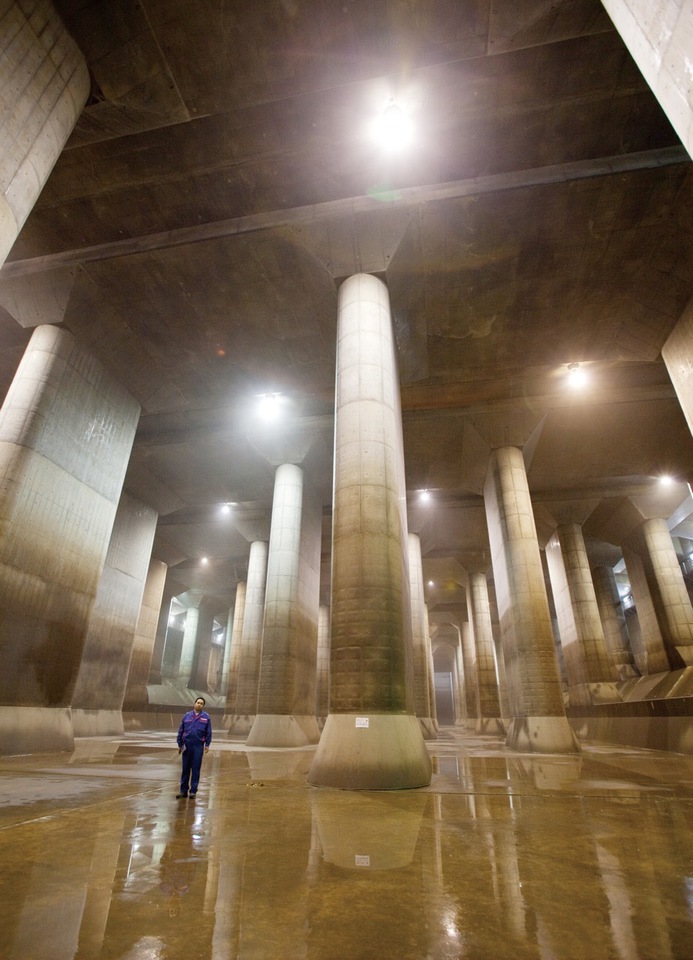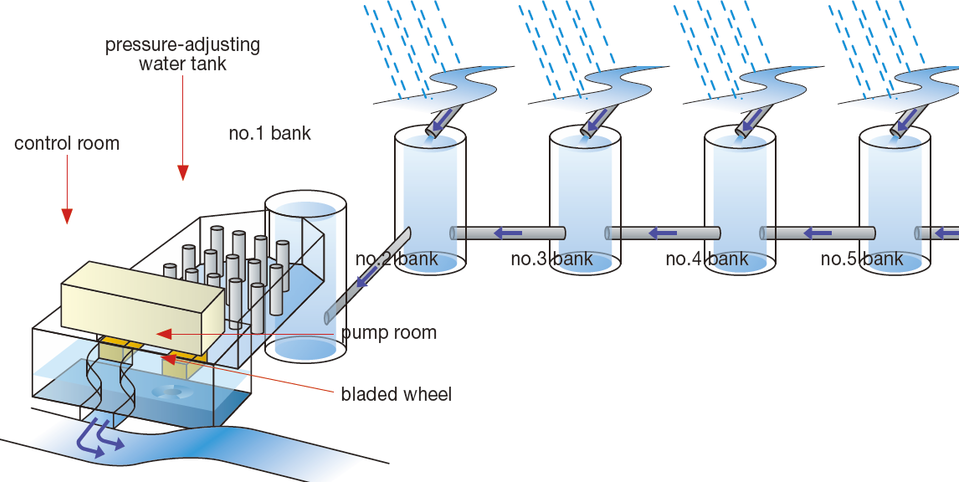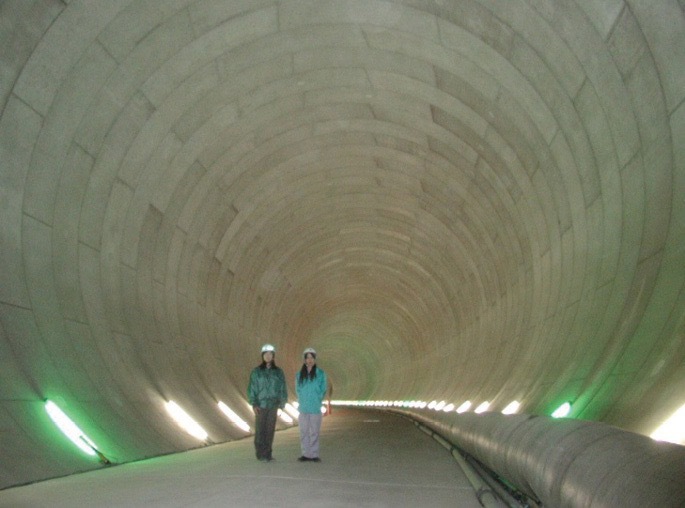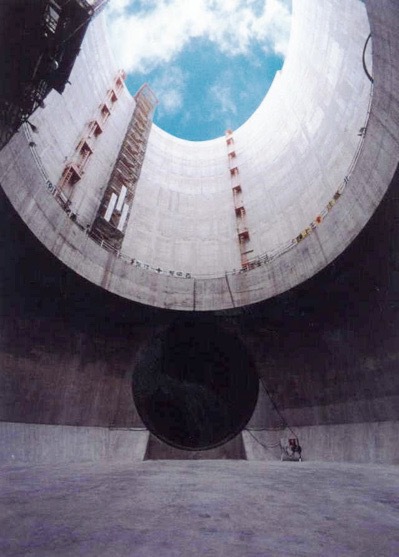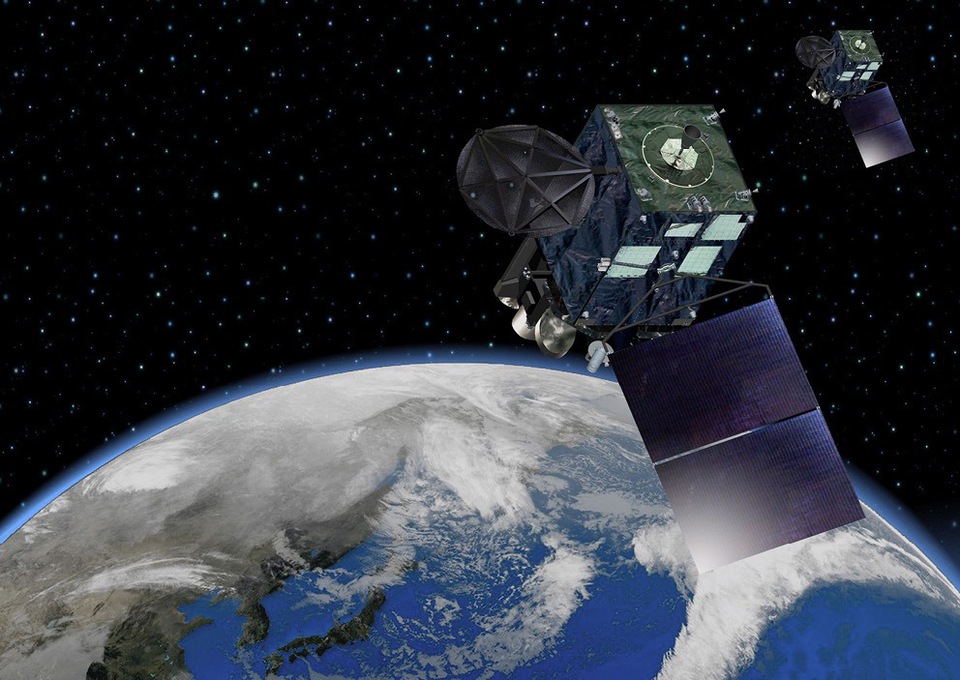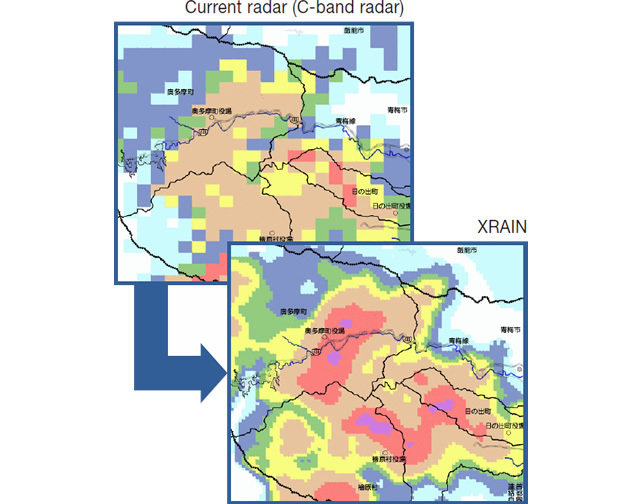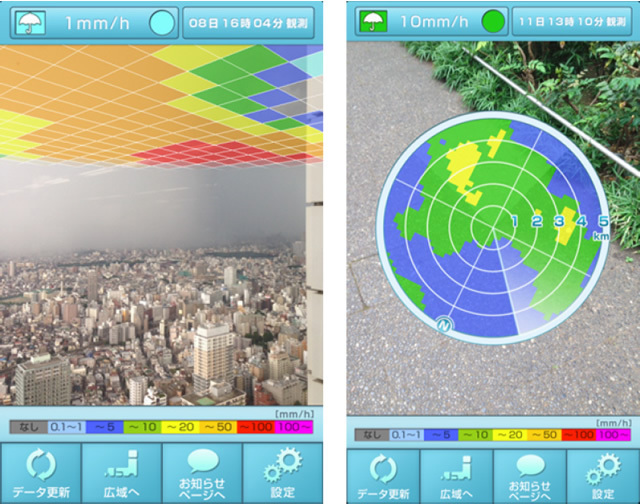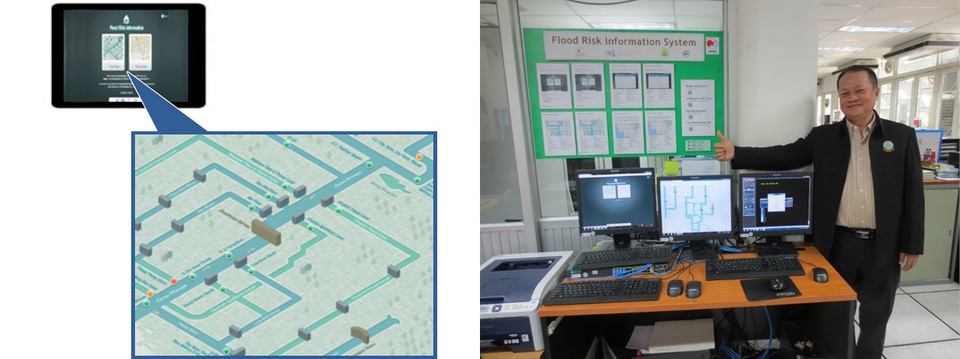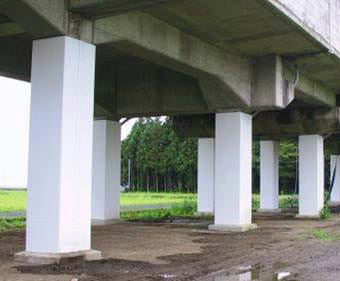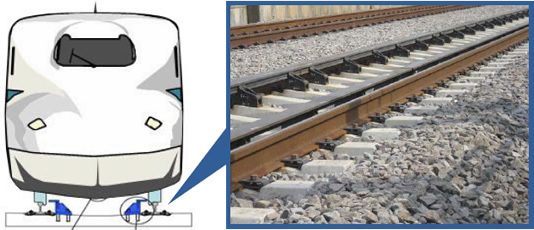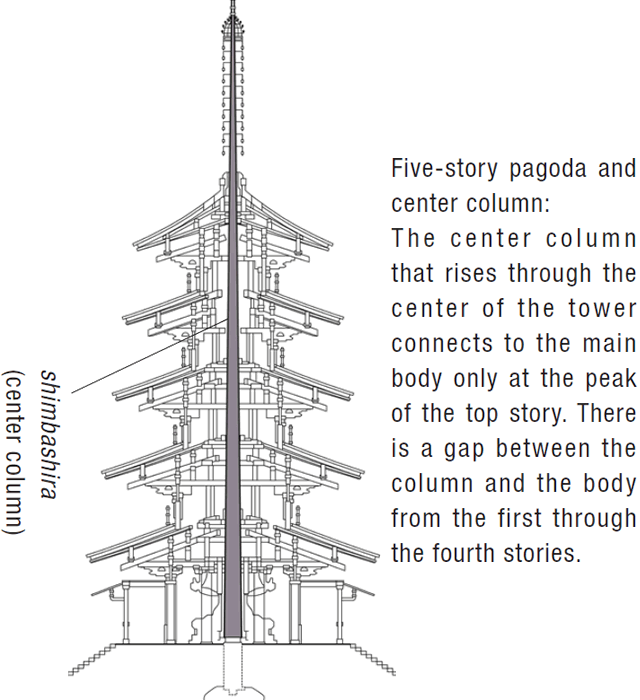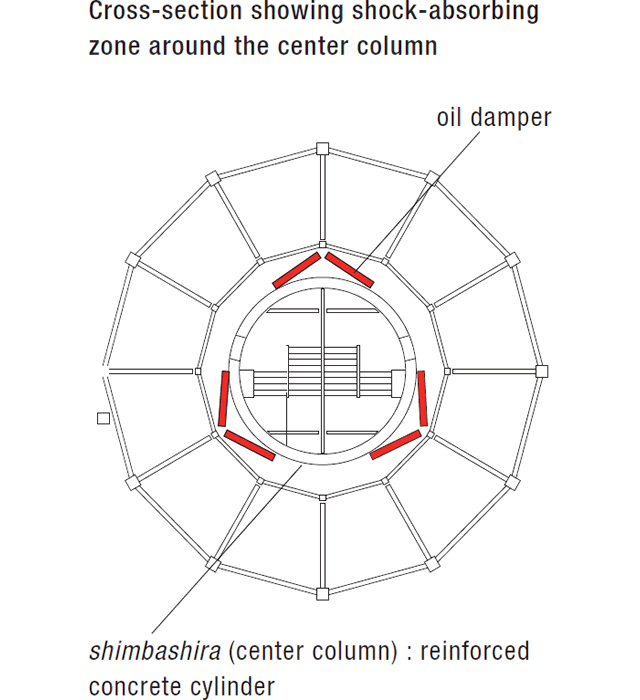These photos show the Metropolitan Area Outer Underground Discharge Channel. The facility, which is 6.3 kilometers (3.9 miles) long, is located 50 meters (164 feet) below the trunk road of metropolitan area. When heavy rain falls, it prevents floods by temporarily storing vast amounts of rainwater and discharging it to the remote rivers. It is an immense facility supported by a wide variety of new technologies, including flood flow inlets, water flow control mechanisms, and highpowered pumps to discharge the stored water to the rivers after the flooding has subsided. This has resulted in dramatically less flood damage in the 987-square-kilometer (381-square-mile) river basin surrounding Tokyo.
While structures such as river levees and dams are important in protecting residents from flood damage, facilities like this also play an unseen but crucial role.
Design of the Metropolitan Area Outer Underground
Discharge Channel
Due to its climatic and geological conditions, Japan experiences a variety of natural disasters including torrential rain caused by typhoons and seasonal rains, earthquakes and volcanic eruptions. And because a large portion of the country is steep mountainous terrain, most of its population and industry are concentrated in the limited flatlands. When a natural disaster occurs, its effects can easily escalate.
Japan has continuously developed disaster measures to overcome such difficult conditions and is known as one of the most advanced countries in terms of disaster reduction. Following are some of Japan’s latest efforts.
Japanese Technology Takes on the Challenge of Water-Related Disasters
Since ancient times, Japan has persevered against frequent water-related disasters. Various technologies cultivated over many years of effort have yielded significant results in disaster reduction.
A continuous monitoring system is essential for reducing the damage caused by waterrelated disasters. Japan has honed weather observation and forecasting technology and developed an early warning information system that makes use of information and communications technology. By continuously monitoring the motion of the atmosphere from space with weather satellites, weather conditions can be ascertained as they change from one moment to the next.
Japan plans to start operations of the world’s first next-generation meteorological satellite (Himawari-8) in 2015. It is drawing attention from around the globe because of its sophisticated monitoring capabilities?boasting three times the number of functions, three times the observation frequency, and double the resolution of current satellites.
But this alone is not enough to grasp hard-to-ascertain localized weather conditions. To accomplish this, Japan has deployed the X-band polarimetric (multiparameter) Radar Information Network (XRAIN). The first of its kind to reach practical application, XRAIN provides detailed measurement of rainfall focusing on metropolitan areas. This radar network measures at a resolution sixteen times higher, and collects data at a frequency five times higher than that of conventional systems and sends that data in real time. By estimating rainfall from the shape of raindrops and ascertaining their direction and speed, it can accurately estimate the amount of rainfall-providing a powerful tool for predicting a water-related disaster within thirty or sixty minutes. The information obtained is widely accessible to the public via smartphone apps and other devices.
Furthermore, in response to a request for technical cooperation from the government of Thailand, which suffered from severe flood damage in 2011, Japan developed and provided a flood forecasting system. Implementing the latest technology combined with water-level observation and satellite data, it has become the world’s first forecasting system capable of predicting areas where flooding may occur, with the accuracy and speed required for practical use. The flood forecast information is widely and easily accessible via computers and mobile devices.
A water management simulator was also developed at the same time, enabling the Thai government to achieve better flood management. It easily provides accurate results of simulations of river discharge related to operation of flood control facilities, including reservoirs. This simulator, jointly developed, was built based on the assumption that it would be operated by the Thai government, which greatly welcomed its development. In this way, Japan’s cutting-edge technology is widely used by the people of Thailand today, and is effective in reducing flood damage.
By mobilizing its advanced technology, Japan continues its contribution to the reduction of damage from water-related disasters around the globe through utilizing such knowledge, technology, and experience.
The XRAIN system can observe and distribute information about the precipitation in more detail. Compared to conventional systems, XRAIN can operate with five times higher frequency and in sixteen times higher resolution.
Useful observation data is distributed via mobile devices. By pointing your phone towards the sky, rain distribution is displayed on the screen, and by pointing it towards the ground, rainfall of the surrounding area is displayed.
The flood forecasting system for the Chao Phraya River in Thailand is easy to use even for non-specialists and can be accessed from tablet devices. Cutting-edge technology makes quick and accurate flood forecasting possible.
Earthquake Countermeasures of the Shinkansen
The year 2014 marked the fiftieth anniversary of the Shinkansen, Japan’s high-speed rail. Its record of zero injuries and fatalities throughout numerous major earthquakes is due to the ceaseless efforts of everyone involved in its operation and development.
Since it began service, the Shinkansen has been equipped with an early earthquake detection system. When the first slight tremors from seismic waves are detected, electrical power is shut down, and the emergency brakes are applied, thereby reducing the speed of the train to a considerable degree before the strong tremors hit. The system is constantly upgraded, and it currently takes only about two seconds for the system to activate the device after primary seismic waves are detected.
Sophisticated earthquake countermeasures have been implemented in ground facilities as well. During the Great Hanshin-Awaji Earthquake in January 1995, elevated rails of the Shinkansen collapsed, causing massive damage. In light of this bitter experience, the railway companies retrofitted the elevated rail bridges against earthquakes, performing work such as reinforcing the bridge piers with steel plates. Since then, no bridge piers have been seriously damaged in major earthquakes.
During the magnitude 6.8 Chuetsu Earthquake in October 2004, a train in service derailed. Fortunately, the cars did not come off the tracks completely and did not overturn because the rail became caught between the wheels and the equipment under the cars, causing the train to stop. Having learned from this incident, the railway companies equipped cars and tracks with derailment prevention devices.
These combined measures have proved successful, and during the Great East Japan Earthquake, all twenty-seven trains in service at the time stopped safely the moment the quake hit. Such accumulated countermeasures implemented in both ground facilities and trains, developed based on experience, ensure the safety of high-speed rail service.
The Early Earthquake Detection System demonstrates its extraordinary effectiveness each time an earthquake hits, ensuring the safety of the high-speed rail service. Development is currently under way to improve the system’ s accuracy and response speed.
The pillars of elevated tracks have been seismically reinforced with steel plates. The white areas are the parts that have been reinforced.
Several measures are in place to prevent derailment. One such measure is the Derailment Prevention Guards installed inside the rails. Another measure is the installation of protrusions to prevent derailment placed on either side of the cars.
World’s Tallest Freestanding Broadcast Tower
Fuses Traditional and Leading-Edge Technologies to Ensure Safety
Completed in February 2012, TOKYO SKYTREE® boasts a height of 634 meters (2,080 feet), making it the world’s tallest freestanding broadcast tower. In Japan, a country prone to earthquakes, it is crucial that the tower be able to maintain its function as a broadcast tower and transmit information in times of disaster. Therefore it was extremely important that the tower be designed to withstand earthquakes.
One of the technologies to ensure this is the vibration control system developed for this tower. The system consists of two structurally independent parts, a center column, or shimbashira (心柱), and the surrounding frame (the main body of the tower), which sway differently when an earthquake hits, thereby counteracting the swaying of each structure, and reducing the overall shaking caused by the quake. A 375-meter (1,230-foot) column rises through the center of the tower. From the ground level for the first 125 meters (410 feet), it is fixed to the steel frame of the tower body, but beyond that it is separated from the frame, connected loosely only by oil dampers. During an earthquake, they move with different resonant frequencies, thus limiting the swaying of the tower.
The system gets its name from the center column used in wooden multistory pagodas?a traditional form of Japanese architecture. Among all the wooden multistory pagodas across Japan that have stood for hundreds of years, including the 31.5-meter (103-foot) five-story pagoda at Horyuji, a classic temple built around A.D. 680, almost none have collapsed in an earthquake. Its structure, in which the center column is structurally independent from the wooden frame of the main body, has remained the same for over 1,300 years, to this day.
Japan's disaster countermeasures have evolved by combining traditional and advanced technologies.
*:The center column not fixed to the walls steadies the structure through the shockabsorbing function of the oil dampers.
**:The column is fixed to the surrounding steel structure with steel beams.































































































































